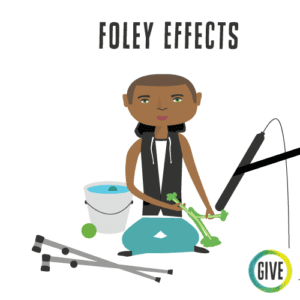Making Foley Sounds
কর্তৃক অবদান লরা বর্গওয়ার্ট
![]()
![]()
Description
This activity helps students discover how the sounds used in movies and animations are created behind the scenes, by practicing making sounds with various objects and matching them with the actors’ actions and moods. Students will have a chance to become actors, Foley artists, and audience members, working in collaboration to build a positive community in the classroom.
দিকনির্দেশ
- Introduce the class to Foley—Foley effects are the sounds that are added to a movie or a play. They help increase the sound quality and help tell a specific story.

- Have students explore different Foley objects—what sounds do they make?
- “Today we are going to make the sounds of different characters moving across the stage. Some characters might be realistic and their footsteps might sound like shoes walking on the floor; some characters might be silly and their footsteps sound a little wacky (e.g., the SpongeBob SquarePants walking noise); and some characters might slither or crawl across the space.”
- Have one actor (maybe a Classroom Professional) move across the stage/space/screen in a specific way. “How did the actor move? Were their movements small/big? Light/heavy? Realistic/silly? Does anyone have a sound effect that matches that character?”
- The actor will cross the space again, this time with the Foley artist matching their movements with sound. “Make sure to pay attention—the sound should happen at the exact moment their foot or other body part hits the floor.”
- Try working backward! Have one of your Foley artists play a sound and have that sound inspire the actor to create a way of moving that matches the Foley.
- প্রতিফলন:
- “Did you like being an actor or a Foley artist better? Why?”
- “What were the important skills we needed in each of the roles?”
- Extensions: You could have a puppet move across the space and match their footsteps, or have the actor “walk” with different parts of their body (e.g., fingers, elbows, etc.).
Transition Into Activity
Enter the space with a hidden squeaker or other Foley object in your hand and match your footsteps with the squeaker. Act very confused and ask the class if they hear that noise. Discover your Foley object.
Transition Out of Activity
“What Foley sound could we use for someone falling asleep/snoring? Let’s all try. Relax. Sleep. Okay, wake up! (Bringggggg!) It’s time to get back to class.”
শ্রেণীকক্ষের ব্যবস্থা
Audience/playing space.
সমর্থন/অভিযোজিত উপকরণ/সরঞ্জাম
- For those with sound sensitivities, you can have headphones available to wear during the game or find a seat for them that is further from the Foley artists.
- Have lots of different kinds of Foley that are manipulated in different ways—squeeze, hit, scrunch, slap. Have options that require both fine motor and gross motor skills.
- If you’re really fancy and have a microphone, place the microphone by the Foley artists so they can use a wider range of objects to make the sound effects.
- Visual Vocabulary Cards (downloadable).
- Video examples to learn about Foley sounds:
Possible Roles for Classroom Professionals
- Model 100% participation—encourage a Classroom Professional to volunteer to be the first actor and invite them to be as silly as they can. Their willingness to take a risk will encourage the students to do so as well.
- Side-coach Foley artists: “Got your object ready? Okay, they are taking the first step—squeeze!”
Adjustments for Remote Instruction
![]()
This is a good game for online classes where some students want to turn on their camera (they can be actors!) and some want to keep their camera off (they can be Foley artists!). Come to class prepared with some examples of objects students may have in their homes to create sound. The actor will need to make sure as much of their body is in the frame as possible, especially if they are walking across their space. Make sure all audience members are on mute so the Foley artist can be heard.
